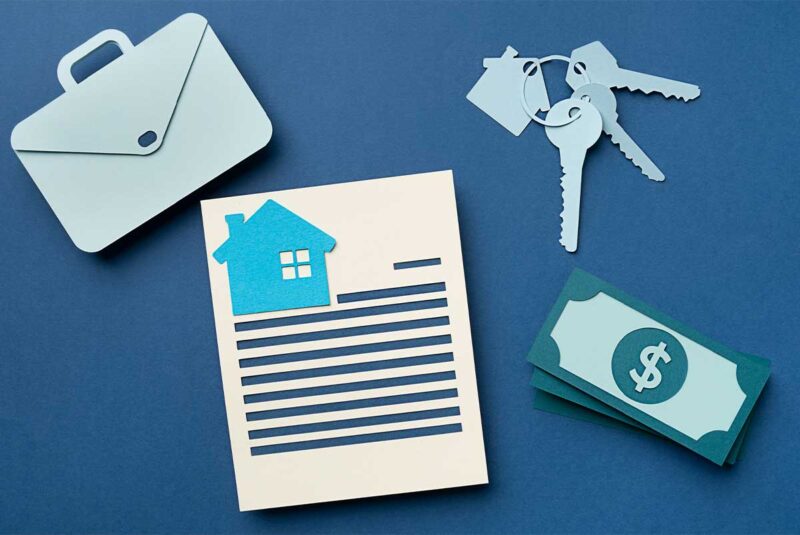Ready To Buy a Home?
Get Approved to Buy a Home
Rocket Mortgage® lets you get to house hunting sooner.
Fewer than 10% of new U.S. home purchases are paid for in cash.[1] The vast majority of Americans pay for their homes through a mortgage. This means that in addition to the overall cost of the home, you’ll also need to consider how much you can afford in a monthly mortgage payment.
Your income is a critical piece of this equation. We’ll cover some general rules and principles to follow, so you don’t bite off more than you can chew or end up house poor.
Understanding Mortgage-to-Income Ratio
When discussing how much of your income should go to your mortgage, the gold standard is the 28% rule – aka the 28/36 rule. We’ll explain this rule later, but to understand it, you need to know what these numbers mean and how they’re calculated.
Front-end ratio
Front-end ratio is also referred to as mortgage-to-income ratio. This is the percentage of your income that goes toward mortgage costs. To calculate it, you simply divide the monthly mortgage payment by the gross monthly income. We’ll look at an example.
Let’s say your gross monthly income is $5,000, and your monthly mortgage payment is $2,000. The calculation would look like this: 2,000 / 5,000 = 0.4.
In this example, your mortgage-to-income ratio is 40%.
Back-end ratio
Back-end ratio takes all of your debts into account, not just your mortgage payment. This number is also referred to as your debt-to-income (DTI) ratio. This number would include things like student loans, auto loans and personal loans.
The way you calculate it is similar. First, you add up your monthly debts, including your mortgage. Then, you divide that figure by your gross monthly income. Here’s an example.
Let’s say, per month, you owe $200 in student loans, a $250 car payment and $2,000 for your mortgage. The first step is to add these debts together: 200 + 250 + 2,000 = 2,450.
We’ll keep $5,000 as the gross monthly income. To calculate your DTI ratio, divide your added expenses by your monthly income. (2,450 / 5,000 = 0.49.)
For this example, your back-end ratio would be 49%.
Popular Rules for Calculating Percentage of Income for Mortgage
Here are some common rules for managing your mortgage as a percentage of your income. You should be in decent shape regardless of which method you follow, so choose the calculation that makes the most sense to you.
28% rule
This rule is also known as the 28%/36% rule. These numbers apply to the front-end and back-end ratios we discussed earlier.
The 28% rule refers to your mortgage-to-income ratio. To follow this rule, your monthly mortgage payment should be 28% or less of your gross monthly income. For example, if your monthly income is $5,000, you can afford up to $1,400 per month on your mortgage. (1,400 / 5,000 = 0.28, which converts to 28%.)
The 36% rule applies to the back-end ratio, or your DTI ratio. On a monthly income of $5,000 your monthly debts can add up to $1,800. (1,800 / 5,000 = 0.36, which converts to 36%.)
The goal in following this rule is to avoid stretching your funds to a breaking point just to cover your living expenses.
35%/45% rule
This is another popular rule. But instead of front-end and back-end ratios, this rule refers to pre-tax and post-tax income.
To follow the first part, your total monthly expenses shouldn’t exceed 35% of your pre-tax income. You can determine this figure by multiplying your monthly pre-tax income by 0.35.
Let’s say you make $5,800 per month before taxes. The calculation would look like: 5,800 X 0.35 = 2,030. That means you can afford to spend up to $2,030 in monthly debt.
For the second part, your monthly debts shouldn’t exceed 45% of your monthly post-tax income. Take your gross monthly income after taxes and multiply by 0.45 to calculate it.
Say you make $5,200 after taxes per month. Your total monthly debts shouldn’t exceed $2,340 if you follow this rule. (5,200 X 0.45 = 2,340.)
25% rule
This rule is for net income calculation. In this case, no more than 25% of your post-tax income can go toward housing costs. Some people prefer this method because they don’t like using gross monthly income.
To calculate it, simply multiply your monthly post-tax earnings by 0.25. For example, 5,500 X 0.25 = 1,375. That means you shouldn’t spend more than $1,375 per month on your mortgage.
Estimate Your Mortgage Payment
To get a sense of how your finances stack up against these rules at different home price points, you’ll need to estimate what your mortgage would look like.
Here’s what goes into a monthly mortgage payment:
- Principal: This is the original loan amount to purchase the house.
- Interest: This is what you pay the lender so they’ll loan you the money. This will be the largest portion of your payment, besides the principal.
- Property taxes: These are taxes you’ll pay based on the assessed value and location of your home.
- Homeowners insurance: Lenders require you to get this insurance to protect the home and your property before they’ll provide financing.
- Mortgage insurance: Depending on how much you put down and the type of mortgage you choose, you could also have to pay private mortgage insurance (PMI) or a mortgage insurance premium (MIP).
Other costs to consider
Remember, there may be additional, property-specific costs to factor in. For example, if the community has a homeowners association (HOA), you’ll probably owe an HOA fee. There might also be repairs that need to be done as soon as you move in – for example, if there’s an issue with the roof or if the home needs a new heating, ventilation and air conditioning (HVAC) unit.
If possible, it’s better to account for these expenses before you finalize the loan.
How Do Lenders Decide How Much House You Can Afford?
To secure a mortgage from a lender, you’ll have to go through mortgage underwriting. This is the period of truth. Your application for a loan will either be approved or denied during this process.
Here are some factors lenders will consider when reviewing your application.
Income
Gross income combines all of your earnings, before taxes, from wages and other income streams. Lenders will use this information to determine how much of a monthly payment you can afford.
Debt-to-income ratio
To qualify for a conventional loan, the recommended DTI ratio shouldn’t exceed 36% — hence the 26/36 rule. Technically, you can still be approved with a ratio as high as 50% if you meet certain requirements.[2]
Credit score
Your credit score is important because it gives lenders a sense for how you’ve managed your debts in the past. If you have a high credit score, lenders view you as being less risky. This translates to better loan terms compared to someone with a moderate to low credit score. If your credit score is too low, you may have trouble qualifying for a mortgage at all.
Down payment
The more you have to put down on a property, the less you’ll owe on the loan. This means a lower monthly mortgage payment, which impacts how the lender will view your application.
For example, if you have a lower credit score but a large down payment, your chances of being approved will be higher than if you had the same credit score with a significantly smaller down payment.
Tips for Lowering Monthly Mortgage Payment
After checking your finances against the guidelines above, you may want to improve your ratios. There are two main ways to do this: increasing your income – which is often easier said than done – or lowering your monthly mortgage payment.
Here are some tips to help you with the latter.
Improve your credit score: The higher your credit score, the better your loan terms. This can result in lower interest rates and lower payments on additional costs, like private mortgage insurance (PMI).
Lengthen the loan term: By lengthening the loan term, you spread out paying back the principal. This means you’ll owe less each month. The downside is that you’ll end up paying more in interest over the life of the loan.
Make a larger down payment: If you put at least 20% down, you won’t owe PMI on your mortgage.[3] Additionally, the more you have to put down, the less you’ll owe each month. A $300,000 home will be more affordable on a monthly basis with 20% down versus 10% down.
Percent of mortgage to income FAQs
It’s not recommended. But these guidelines allow for some wiggle room depending on your situation.
For example, if you’re expecting to get a raise or don’t have any other major monthly debts – like student loans or auto loans – it might make sense to have a higher ratio for a little while.
At the end of the day, it’s your life. If you’re willing to cut back on spending in other areas for the sake of owning property, the tradeoffs might be worth it to you.
If you make $70,000, your gross monthly income would be about $5,833. To follow the 28% rule, your full monthly mortgage payment should be $1,630 or less.
To do this for any other salary, start by dividing your salary by 12. This will calculate your gross monthly income.
From there, multiply your gross monthly income by 0.28. That number is how much you can spend on your mortgage each month if you follow the 28% rule.
Annual income / 12 = gross monthly income. Gross monthly income X 0.28 = maximum mortgage payment that follows the 28% rule.
This depends on the type of loan you’re applying for. For example, there are no minimum income requirements for an FHA loan. If you’re applying for a conventional loan, your lender will need to verify your income. How much income you’ll need will depend on factors like your credit score, DTI ratio and down payment amount.
Live Within Your Means
It’s important to buy a home that you can afford, even if you have to settle for less than your ideal – at least initially. One of the primary benefits of purchasing a home is that you begin to build equity. Down the road, you can leverage this equity into another home purchase.
Get approved to buy a home.
Rocket Mortgage® lets you get to house hunting sooner.
The Short Version
- Front-end ratio is also known as mortgage-to-income ratio, while back-end ratio is known as debt-to-income ratio. The numbers in the most well-known rule refer to these ratios
- The 28% rule, which says less than 28% of your monthly income should go to your mortgage, is the most popular. Other rules consider pre-tax versus post-tax earnings
- Your monthly mortgage payment will be a combination of expenses, including the principal of the loan, interest, property taxes and insurance
U.S. Census Bureau. “New Houses Sold by Sales Price: United States.” Retrieved February 2023 from https://www.census.gov/construction/nrs/pdf/quarterly_sales.pdf
Fannie Mae. “Selling Guide.” Retrieved February 2023 from https://selling-guide.fanniemae.com/Selling-Guide/Origination-thru-Closing/Subpart-B3-Underwriting-Borrowers/Chapter-B3-6-Liability-Assessment/1032992131/B3-6-02-Debt-to-Income-Ratios-02-05-2020.htm
Freddie Mac. “Down Payments & PMI.” Retrieved February 2023 from https://myhome.freddiemac.com/buying/down-payments-and-pmi




